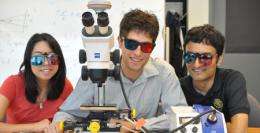Giving fossils a new look

You wouldn’t expect studying fossils to be a part of engineering research, but a team in the Department of Electrical and Computer Engineering is applying computer engineering ingenuity to find a new method for digitizing, studying and sharing microfossil samples.
Professor Dileepan Joseph, PhD candidate Adam Harrison, and master’s of science student Cindy Wong have developed a new way to digitally capture and display microfossils and other specimens, called Virtual Reflected-Light Microscopy.
The process is achieved by capturing a series of digital images of a microfossil through a microscope. Each image is taken with a light source shifted at different points around the sample, which creates different shadows on its surface. This allows the team to extract a three-dimensional map of the sample, which computer software can further interpret. The result is imagery that is on par with viewing a real microfossil sample. Users can control the angle, intensity, and type of light hitting the sample, and can even view it in 3-D using 3-D glasses.
“In the past, researchers might get a few images of a specimen under a few lighting conditions. It would give them the general outline and some other properties, but it was not comparable to actually looking at a specimen,” Harrison said. “What we’re doing is like reverse engineering: using multiple images together to extract the shape of samples. And with that we get important properties such as surface reflectance."
Harrison says this imaging technology could facilitate a massive digital library of samples that can be accessed through a web browser. He says this eliminate the need for researchers to travel to view samples that are stored in large repositories all over the world.
“You can have the best digital representation in the world, but if you can’t share it, it doesn’t matter,” Harrison said.
For her part in the project, Wong developed a Java applet that allows end users to interact with the samples in a simple, intuitive way.
“This is a much closer representation of using an actual microscope,” she said. “It is also a way to share information with a larger audience easily and more cost effectively.”
The method could change the way geoscientists examine the vast quantity of microscopic samples that are collected through projects like the Integrated Ocean Drilling Program. These microfossils provide researchers with information that is crucial for climate study, and oil and gas exploration.
“We’re interested in ways of accelerating the identification process,” Joseph said. “This definitely gets us closer to that goal.”
While the team continues to refine their system, they’re also looking at other uses. Because it can record data from any opaque material, Joseph says there is the potential for applications in metallurgic study. The team has also been in contact with the Natural History Museum in London, UK, which is providing samples from its large collection of microfossils.
“There’s huge potential for educating the public with VRLM,” Joseph said. “People respond to its interactive nature.”
Provided by University of Alberta


















